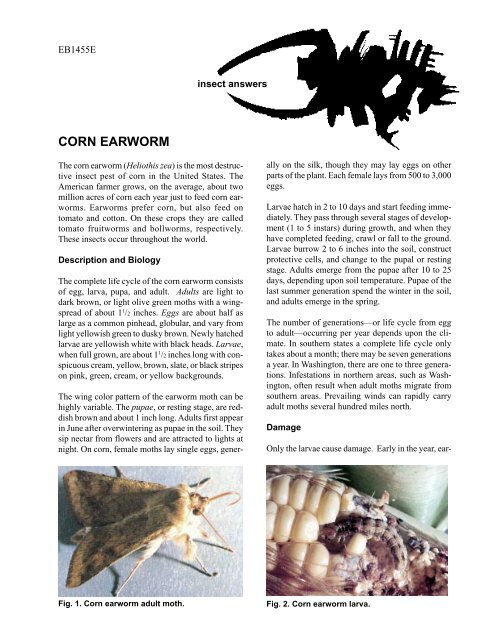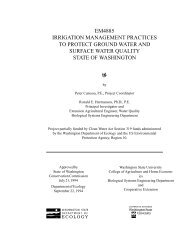CORN EARWORM - Washington State University
CORN EARWORM - Washington State University
CORN EARWORM - Washington State University
You also want an ePaper? Increase the reach of your titles
YUMPU automatically turns print PDFs into web optimized ePapers that Google loves.
EB1455E<br />
<strong>CORN</strong> <strong>EARWORM</strong><br />
insect answers<br />
The corn earworm (Heliothis zea) is the most destructive<br />
insect pest of corn in the United <strong>State</strong>s. The<br />
American farmer grows, on the average, about two<br />
million acres of corn each year just to feed corn earworms.<br />
Earworms prefer corn, but also feed on<br />
tomato and cotton. On these crops they are called<br />
tomato fruitworms and bollworms, respectively.<br />
These insects occur throughout the world.<br />
Description and Biology<br />
The complete life cycle of the corn earworm consists<br />
of egg, larva, pupa, and adult. Adults are light to<br />
dark brown, or light olive green moths with a wingspread<br />
of about 1 1 /2 inches. Eggs are about half as<br />
large as a common pinhead, globular, and vary from<br />
light yellowish green to dusky brown. Newly hatched<br />
larvae are yellowish white with black heads. Larvae,<br />
when full grown, are about 1 1 /2 inches long with conspicuous<br />
cream, yellow, brown, slate, or black stripes<br />
on pink, green, cream, or yellow backgrounds.<br />
The wing color pattern of the earworm moth can be<br />
highly variable. The pupae, or resting stage, are reddish<br />
brown and about 1 inch long. Adults first appear<br />
in June after overwintering as pupae in the soil. They<br />
sip nectar from flowers and are attracted to lights at<br />
night. On corn, female moths lay single eggs, gener-<br />
ally on the silk, though they may lay eggs on other<br />
parts of the plant. Each female lays from 500 to 3,000<br />
eggs.<br />
Larvae hatch in 2 to 10 days and start feeding immediately.<br />
They pass through several stages of development<br />
(1 to 5 instars) during growth, and when they<br />
have completed feeding, crawl or fall to the ground.<br />
Larvae burrow 2 to 6 inches into the soil, construct<br />
protective cells, and change to the pupal or resting<br />
stage. Adults emerge from the pupae after 10 to 25<br />
days, depending upon soil temperature. Pupae of the<br />
last summer generation spend the winter in the soil,<br />
and adults emerge in the spring.<br />
The number of generations—or life cycle from egg<br />
to adult—occurring per year depends upon the climate.<br />
In southern states a complete life cycle only<br />
takes about a month; there may be seven generations<br />
a year. In <strong>Washington</strong>, there are one to three generations.<br />
Infestations in northern areas, such as <strong>Washington</strong>,<br />
often result when adult moths migrate from<br />
southern areas. Prevailing winds can rapidly carry<br />
adult moths several hundred miles north.<br />
Damage<br />
Only the larvae cause damage. Early in the year, ear-<br />
Fig. 1. Corn earworm adult moth. Fig. 2. Corn earworm larva.
worms attack the buds or central shoots of young corn<br />
by feeding on the tender, unfolding leaves, or later,<br />
on the tassels. Serious damage occurs when earworms<br />
attack corn ears. They first feed on silk, preventing<br />
pollination and kernel development. They may penetrate<br />
down the ear, and often eat all the kernels halfway<br />
down the ear. Larvae leave moist castings from<br />
their feeding. These castings, frequently visible at the<br />
tip of the ear, render the corn unsalable.<br />
Control<br />
Cultural, biological, and chemical techniques are<br />
available for corn earworm control. Sometimes a<br />
mixture of techniques is best. The type(s) of control<br />
selected depends on the situation.<br />
Cultural Control. Plant corn resistant to earworm.<br />
Any corn variety with long, tight husks is physically<br />
safer from earworms. Resistant varieties include<br />
Country Gentlemen, Staygold, Golden Security, and<br />
Silvergent. Placing a clothes pin at the point where<br />
silk enters the ear helps keep worms out of ears. This<br />
also should be done soon after the first silk emerges.<br />
Early season plantings (before April) are damaged<br />
less because the corn matures before large earworm<br />
populations develop. In the fall, plow or dig up the<br />
soil where corn was grown. Plowing exposes pupae<br />
to killing winter temperatures and destroys exit tunnels<br />
through the soil, which larvae constructed<br />
before they pupated. Any adults surviving the winter<br />
are then trapped under the soil.<br />
Biological Control. Many beneficial insect parasites,<br />
predators, and several diseases attack corn earworm.<br />
An egg parasite wasp, Trichogramma, lays eggs<br />
inside the earworm egg. This wasp occurs throughout<br />
North America. Releases of this parasite into corn<br />
fields to control corn earworm have been successful,<br />
achieving 50% to 100% parasitism. Several firms<br />
specialize in rearing Trichogramma parasites, and<br />
offer these biocontrol agents for sale.<br />
Green lacewings, which eat earworm larvae, are also<br />
available from different firms for release in grower<br />
fields. Additional predators include a native soldier<br />
beetle that enters the earworm tunnel and eats the<br />
worms, and a flower bug that eats eggs and larvae on<br />
the silk. A natural bacterial pathogen, Bacillus<br />
thuringiensis (B.T.), and a nuclear polyhedrosis<br />
virus also kill earworm larvae.<br />
Selective, natural pathogens eliminate pests without<br />
harming the environment. Bacillus thuringiensis is<br />
such an insecticide, sold under the trade name Dipel ® .<br />
This insecticide kills only moth larvae and not beneficial<br />
insects. In general this product works better<br />
when combined with feeding stimulants. Apply these<br />
materials after 4 p.m., as they break down rapidly in<br />
heat and sunlight.<br />
Chemical Controls. Applying mineral oil to the silk<br />
just inside the tip of each ear with an oil can is an<br />
effective control. Mineral oil suffocates young larvae.<br />
Mark treated corn ears with tape so later developing<br />
ears can also be treated. Oil applied before the<br />
silk starts to dry may interfere with pollination.<br />
For large, commercial fields under heavy earworm<br />
attack, Ambush ® , Pounce ® , Sevin XLR Plus ® , and<br />
Lannate ® will probably give the best protection, while<br />
causing the least hazard to honeybees foraging corn<br />
fields for pollen. Apply before 6 a.m. or after 3 p.m. to<br />
reduce damage to bees. Time insecticide sprays to control<br />
the larvae and eggs on the corn silk. Make the first<br />
application before 10% of the plants are in silk.<br />
By Daniel F. Mayer, Retired WSU Extension entomologist; Arthur L. Antonelli, Extension entomologist, WSU Puyallup Western <strong>Washington</strong><br />
Research and Extension Center; and Roy VanDenburgh, Retired WSU Extension agent.<br />
Warning The law requires that pesticides be used as the label directs. Uses against pests not named on the label and low application rates<br />
are permissible exceptions. If there is any apparent conflict between label directions and the pesticide uses suggested in this publication,<br />
consult your county Extension educator.<br />
Issued by <strong>Washington</strong> <strong>State</strong> <strong>University</strong> Cooperative Extension and the U.S. Department of Agriculture in furtherance of the Acts of May<br />
8 and June 30, 1914. Cooperative Extension programs and policies are consistent with federal and state laws and regulations on nondiscrimination<br />
regarding race, sex, religion, age, color, creed, national or ethnic origin; physical, mental or sensory disability; marital status,<br />
sexual orientation, and status as a Vietnam-era or disabled veteran. Evidence of noncompliance may be reported through your local<br />
Cooperative Extension office. Trade names have been used to simplify information; no endorsement is intended. Revised March 2003.<br />
Subject codes 352, 275.<br />
EB1455E
















